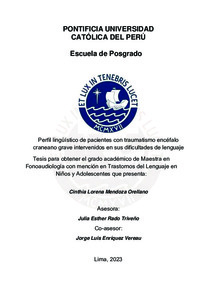| dc.contributor.advisor | Rado Triveño, Julia Esther | |
| dc.contributor.advisor | Enríquez Vereau, Jorge Luis | |
| dc.contributor.author | Mendoza Orellano, Cinthia Lorena | |
| dc.date.accessioned | 2023-11-15T17:29:17Z | |
| dc.date.available | 2023-11-15T17:29:17Z | |
| dc.date.created | 2023 | |
| dc.date.issued | 2023-11-15 | |
| dc.identifier.uri | http://hdl.handle.net/20.500.12404/26438 | |
| dc.description.abstract | El objetivo de esta investigación fue conocer cómo se ve afectado el perfil lingüístico de las
personas con antecedente de traumatismo encéfalo craneano grave y cómo era la evolución
de los mismos, para lo cual se evaluaron a 5 pacientes en 2 momentos y se determinó que, 4
tuvieron avances significativos en los diversos componentes de lenguaje, con un porcentaje
mayor a 70%, considerando los factores externos (edad, sexo, nivel socioeconómico, nivel
de daño de la lesión) como determinantes en el seguimiento de evolución de cada paciente.
La metodología fue descriptiva, el investigador recogió información de dos o más muestras
con el fin de observar el comportamiento de una variable. Los instrumentos empleados
fueron entrevistas a los pacientes y la aplicación de la adaptación peruana del Test de Boston,
que ayudó a conocer sus dificultades de lenguaje de cada paciente. El resultado de este
estudio fue diferenciar los aspectos evolutivos de lenguaje en dos diferentes tiempos,
después de un periodo de intervención que fue mayor a 3 meses. | es_ES |
| dc.description.abstract | The objective of this research was to know how the linguistic profile of people with a
history of severe cranial trauma was affected and what their evolution was like, for which
5 patients were evaluated in 2 moments and it was determined that, 4 They had significant
advances in the various language components, with a percentage greater than 70%,
considering external factors (age, sex, socioeconomic status, level of injury damage) as
determining factors in the follow-up of the evolution of each patient. The methodology
was descriptive, the researcher collected information from two or more samples in order
to observe the behavior of a variable. The instruments used were interviews with the
patients and the application of the Peruvian adaptation of the Boston Test, which helped
to determine the language difficulties of each patient. The result of this study was to
differentiate the evolutionary aspects of language at two different times, after an
intervention period that was longer than 3 months. | es_ES |
| dc.language.iso | spa | es_ES |
| dc.publisher | Pontificia Universidad Católica del Perú | es_ES |
| dc.rights | info:eu-repo/semantics/openAccess | es_ES |
| dc.rights.uri | http://creativecommons.org/licenses/by-nc-sa/2.5/pe/ | * |
| dc.subject | Traumatismo | es_ES |
| dc.subject | Lenguaje--Evaluación | es_ES |
| dc.subject | Afasia--Evaluación | es_ES |
| dc.subject | Cerebro--Enfermedades | es_ES |
| dc.title | Perfil lingüístico de pacientes con traumatismo encéfalo craneano grave intervenidos en sus dificultades de lenguaje | es_ES |
| dc.type | info:eu-repo/semantics/masterThesis | es_ES |
| thesis.degree.name | Maestro en Fonoaudiología con mención en Trastornos del Lenguaje en Niños y Adolescentes | es_ES |
| thesis.degree.level | Maestría | es_ES |
| thesis.degree.grantor | Pontificia Universidad Católica del Perú. Escuela de Posgrado. | es_ES |
| thesis.degree.discipline | Fonoaudiología con mención en Trastornos del Lenguaje en Niños y Adolescentes | es_ES |
| renati.advisor.dni | 10301200 | |
| renati.advisor.orcid | https://orcid.org/0000-0003-3392-9804 | es_ES |
| renati.author.dni | 74999870 | |
| renati.discipline | 916137 | es_ES |
| renati.juror | Vilca Jara, Julissa Yolanda | es_ES |
| renati.juror | Rado Triveño, Julia Esther | es_ES |
| renati.juror | Enríquez Vereau, Jorge Luis | es_ES |
| renati.level | https://purl.org/pe-repo/renati/level#maestro | es_ES |
| renati.type | https://purl.org/pe-repo/renati/type#tesis | es_ES |
| dc.publisher.country | PE | es_ES |
| dc.subject.ocde | https://purl.org/pe-repo/ocde/ford#3.05.03 | es_ES |







